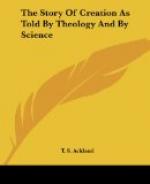When we proceed to examine the narrative more closely, two important questions suggest themselves:—l. What special interference of Creative Power does it indicate? 2. What is the meaning of the division between the waters which were above the firmament and the waters which were under the firmament?
1. What special interference of Creative Power took place on the second day? Till within the last ten years, it would have been difficult to give a satisfactory answer to this question; for if all the elements were already in existence at the commencement of the second day, their arrangement would, as it seems, have been brought about by the ordinary operation of natural laws which were already established. The cooling and condensation of a portion of the elements would have been effected by the radiation of their heat, and the portions thus condensed would, under the influence of gravitation, have arranged themselves in immediate proximity to the centre of gravity, forming a solid or fluid nucleus, round which those portions which still remained in a gaseous state would have formed an atmospheric envelope. But here again the spectroscope comes to our aid. In many of the nebulae which give in it the bright lines indicative of gas, hydrogen and nitrogen are the chief gases discovered. These must be in an incandescent state, or they would not be visible at all. But hydrogen cannot, in the present state of things, remain in this condition in contact with oxygen; it must instantly combine with it, that combination being attended with intense heat, and resulting in the production of water. The introduction of oxygen, then, must involve a very important crisis in the process of development; but that introduction must have preceded the formation of atmospheric air and water. Prior to the second day oxygen must either have been non-existent, or it must have existed in a form and under conditions very different from those under which it exists now. Free oxygen cannot be in existence in the sun or in any celestial object in which the spectroscope indicates the existence of incandescent hydrogen. The special act of the second day would appear to have consisted in the development of oxygen, or the calling it from a quiescent state into active operation.
But the effects of the new element thus called into operation would not be limited to the production of air and water. It is estimated that oxygen constitutes, by weight, nearly half of the solid crust of the earth. It forms a part of every rock and of every metallic ore. The second day, then, must have been a period of intense chemical action, resulting from the introduction of this powerful agent.




